Editors’ Note:
On May 11, 2022, the Department of the Interior released a report—Federal Indian Boarding School Initiative Investigative Report —which describes the horrific practices systematically inflicted on at least 150,000 Native American children for 150 years.
The investigation for this report was begun only after the June 2021 discovery in Canada of 751 unmarked graves near a former Canadian Indigenous Boarding school. Word of this discovery and the questions surrounding it sent shock waves internationally, and questions quickly shifted to this country and its far larger system of Indigenous “boarding schools,” which were the model for the Canadian “schools”: How many boarding schools were there in the U.S.? How many children's bodies are there buried near them? And what were the conditions and treatment of these children that caused their deaths?1
The description of that treatment draws from annual reports by the same department over that whole span of time, as well as two overall reports: the 1928 Meriam Report, and 1969 Kennedy Report.
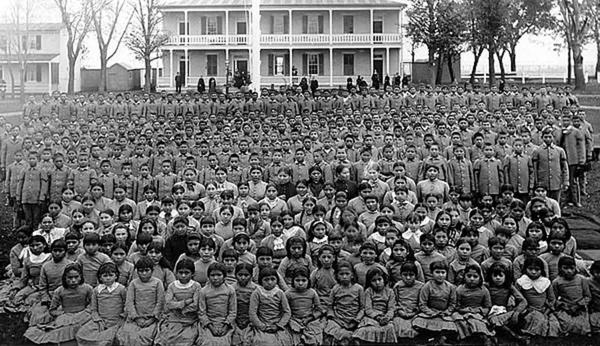
Native American student body at boarding school in Carlisle, Pennsylvania, c1900. Photo: Wikipedia
In Their Own Words:
In 1902, Commissioner of Indian Affairs William A. Jones described the main goal of applying systematic militarized and identity-alteration methodologies in the federal Indian boarding school system as follows:
The young of the wild bird, though born in captivity, naturally retains the instincts of freedom so strong in the parent and beats the bars to secure it, while after several generations of captivity the young bird will return to the cage after a brief period of freedom. So with the Indian child. The first wild redskin placed in the school chafes at the loss of freedom and longs to return to his wildwood home. His offspring retains some of the habits acquired by the parent. These habits receive fresh development in each successive generation, fixing new rules of conduct, different aspirations, and greater desires to be in touch with the dominant race.2
~~~~~~~~~~
As we described in American Crime Case #40: Native American Boarding Schools: “Kill the Indian, Save the Man,” “The near extermination of the Native Americans in the centuries following 1492 is one of the great historical crimes committed by the rulers of this country—or any country.” Through the combination of massive epidemics and the “Indian Wars” waged by the U.S. Army through the decades after the Civil War, by 1890 the estimated Native American population had been reduced by over 90 percent.
But hand-in-hand with this monstrous genocide of the Native American people was a century and more of cultural genocide—forced assimilation through “education.” The current report identifies at least 408 government-run “Indian boarding schools” in 37 states and then-territories of Hawai'i and Alaska between 1819 and 1969. To date they've also located 53 separate grave sites and expect to find more. Though they refuse to release the locations of the sites or the number of graves, their own estimates are that tens of thousands of children did not survive their treatment there.
The report investigating the federal Indian boarding schools includes a letter putting them in “historical context”: “The United States established this system as part of a broader objective to dispossess Indian Tribes, Alaska Native Villages, and the Native Hawaiian Community of their territories to support the expansion of the United States. The federal Indian boarding school policy was intentionally targeted at American Indian, Alaska Native, and Native Hawaiian children to assimilate them and, consequently, take their territories.”
These were NOT “boarding schools”
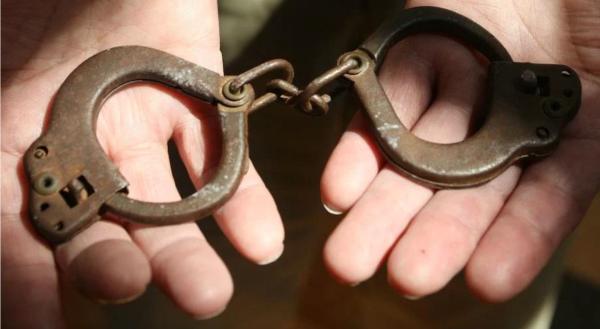
Small child's handcuffs were donated by Native American Shane Murray to the Haskell Indian Nations University’s Cultural Center and Museum in Lawrence, Kansas in 1989. Shane's grandfather told him the cuffs were “used to take Indian kids to school." Photo: Mary Annette Pember
The federal “boarding school” system was an ongoing crime against humanity, where tens of thousands of Native American children were held in prison-like conditions while being subjected to enforced 'assimilation.' The children lived a daily nightmare. They were kept from their families, friends and tribes for years, stripped of their language, culture, customs—their identity—and taught to despise themselves in order to be assimilated into a society that despised them. All of this was done by force wherever necessary. Children who tried to run away were hunted down, returned, and beaten as a lesson to others.
What was the explicit goal of these “boarding schools?”
The Indian boarding schools were designed to separate a child from his reservation and family, strip him of his tribal lore and mores, force the complete abandonment of his native language, and prepare him for never again returning to his people.”3
“Systematic militarized and identity-alteration methodologies”
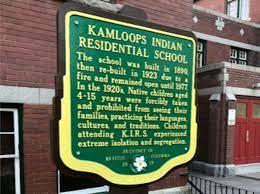
Plaque at Kamloop Indian boarding school in Canada where remains of 215 children were found, May 2021. It reads in part—"In the 1920s Native children aged 4-15 years were forcibly taken and prohibited from seeing their families, practicing their languages, cultures, and traditions. Children attending K.I.R.S experienced extreme isolation and segregation."
Children on the reservations as early as four years old were taken from their parents and communities by force—at gunpoint if necessary—and parents punished if they tried to resist. The children were taken to off-reservation “boarding schools” where they would remain for up to a decade. Some studies suggest that by 1926, nearly 83 percent of Native American school-age children were in the system. As many as 150,000 children or more experienced this unconscionable treatment over more than a century.
“Systematic militarized and identity-alteration methodologies” were used to erase the cultural identity of the American Indian, Alaska Native, and Native Hawai‘ian children. Upon arrival every child's name was replaced with an English name, and their hair—a symbol of pride and one’s connection to the Earth for many Indigenous cultures—was cut. Their traditional clothes were taken and replaced with military-style uniforms; they were forbidden to use their Native languages, religions and cultural practices, and were forcibly converted to Christianity.
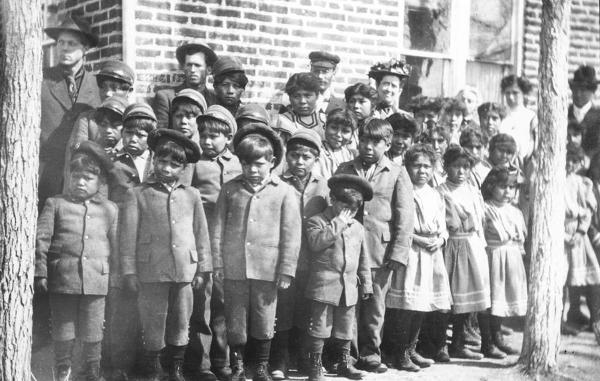
Native American student body at boarding school in Panultch, Utah, c1900. Photo: Utah archives
When first brought in they are a hard-looking set. Their long tangled hair is shorn close, and then they are stripped of their Indian garb thoroughly washed, and clad, in civilized clothing. The metamorphosis is wonderful, and the little savage seems quite proud of his appearance. Teaching the young Indian child to speak English is essentially the first step in his training...No Indian is spoken[:] There is not an Indian pupil... who is permitted to study any other language than our own vernacular – the language of the greatest, most powerful, and enterprising nationalities beneath the sun. (From the 1904 Annual Report.)
Indian boarding school rules were often enforced through corporal punishment. Physical abuse and the solitary confinement of children were common, including punishments like “flogging; withholding food; whipping; slapping; and cuffing.” (From the 2022 investigative report.) Some schools forced older students to physically punish younger children. Children who tried to run away from their captors were hunted down, brought back, and beaten as a warning to others.
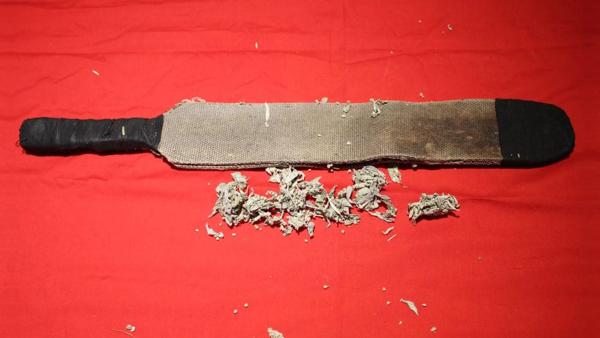
A strap made from conveyor belt mesh was used to punish Indigenous children at St. Margaret’s Indian Residential School in Couchiching First Nation, Ontario. End of strap was reported to contain human blood. Photo: Martha Troian
The conditions at these so-called schools were cramped and dangerous. A report from 1896 describes “three children to each bed” at one location, another where all the beds were pushed together, with each bed having two or more children. Nutrition was nonexistent as the same report concluded, “the outstanding deficiency is in the diet furnished the Indian children, many of whom are below normal health.”
The 1928 Meriam Report admitted “frankly and unequivocally that the provisions for the care of the Indian children in boarding schools are grossly inadequate.” Rampant physical, sexual, and emotional abuse; disease; malnourishment; overcrowding; and lack of health care in Indian boarding schools are well-documented. All of these conditions fueled communicable diseases such as tuberculosis, influenza, and smallpox, especially among students weakened by trauma and meager rations. Schools had their own cemeteries—and students often built their classmates’ coffins.
Education? Not Schools, but Child Labor Camps
Besides English, their main course work consisted of various kinds of vocational training in subjects like manual labor, housekeeping, and farming; and students were usually required to help “keep the school self-sufficient” by laboring there when they were not in the classroom. The Meriam Report found that the boarding schools were acting as child labor camps. Even the youngest students were forced into manual labor such as lumbering, railroad, carpentering, irrigation, well-digging and construction. They also made the point that the training they received was too out-of-date to help them get work when they left.
Religious orders had built the first “schools” for indigenous people, determined to convert the “savages” to Christianity. As the government organized the system of “forced assimilation,” they recruited church-operated schools into the national system. At one point nearly half of the schools were operated by Christian churches. The Supreme Court allowed the government to pay church-run schools with money they were siphoning off—stealing—from Indian funds held in trust accounts, and later the government gave the churches land that was for Native Americans under treaty law.

Arizona Native American girls forced to pray at their beds, c1900.
Multi-Generational Trauma
The historical trauma and damage from this American genocide has had a tremendous impact on the indigenous peoples of North America as a whole down to today. This crime against Native people has left lasting scars. “There is not a single American Indian, Alaskan Native or Native Hawaiian in this country whose life hasn’t been affected by the schools.”
Research about boarding school survivors shows higher rates of chronic health problems that could be passed down to children. “The increased trauma that men faced in the Indian boarding school system may have produced increased stress, which then may affect the biological systems of the body,” according to the report. That trauma includes a generation-after-generation pattern of cultural and family disruption under direct and indirect support by the U.S. government.4
**************************
Put these crimes together with the four centuries of the unspeakable enslavement and continuing oppression and degradation committed against African Americans, and think about the words spoken by the escaped slave Frederick Douglass, on July 5, 1852. He said this country is guilty of “crimes which would disgrace a nation of savages. There is not a nation on the earth guilty of practices more shocking and bloody than are the people of the United States, at this very hour.” These crimes and so many more (see the American Crime series) have been essential to the development of this capitalist-imperialist system down to today. And only through an actual revolution can we finally put an end to these horrors.
